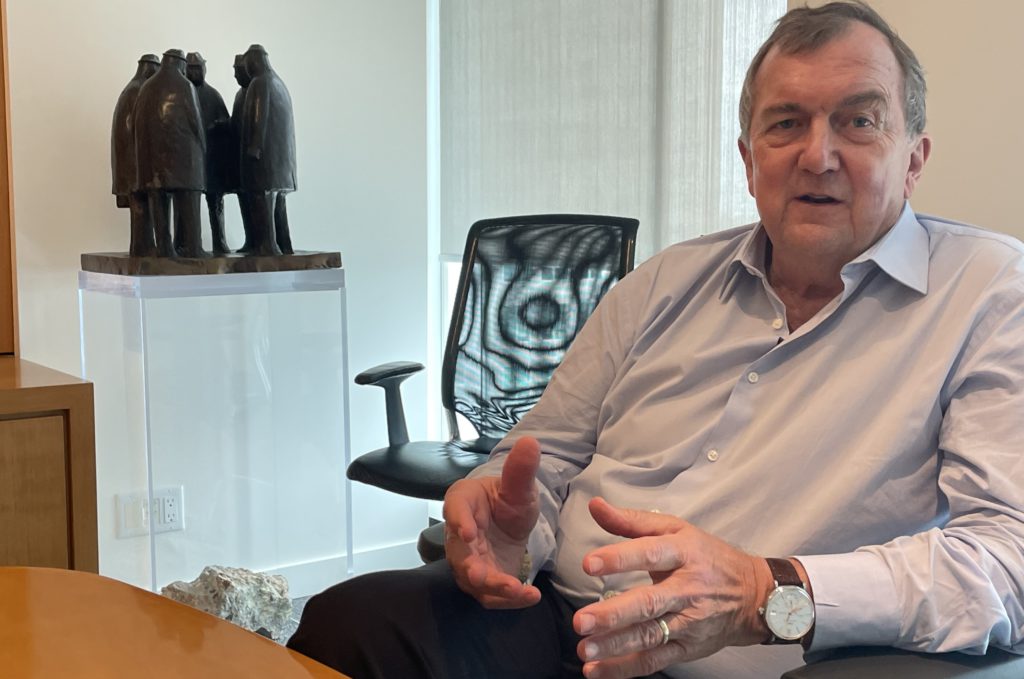“We poured our first bar of gold under the new company – we don’t make too much fuss about it,” Bristow said with a laugh in the Barrick headquarters in Toronto before turning more serious. “We’ve got some work to do re-erecting the power towers after people blew them up.”
Tribal conflicts and protests have downed power lines several times since Porgera started production in 1990 under Canada’s Placer Dome which Barrick acquired in 2006 and may continue even with the new agreement. Assaults on illegal miners and toxic waste claims dogged the operation, like at the Acacia mine in Tanzania.
But Bristow, who’s led the company since it merged in 2019 with the South African company he built, Randgold Resources, transformed Acacia after what he called “a great deal for a crippled organization.”
Barrick had 72% of Acacia but no management control when authorities shut it down forcing the company to take it private and renegotiate operations over several years. At the giant Reko Diq copper project in Pakistan, it took a decade to resolve arbitration in Barrick’s favour, and four years to sort out Papua New Guinea’s nationalization of Porgera.
Reko Diq
Now, Porgera has an ownership structure where locals control more than half the company and its profit, similar to how Barrick is developing Reko Diq with half split evenly between the central government and Baluchistan state, leaving Barrick with half. Operating in locations deemed risky is about building partnerships because without permissions, the mines shut, Bristow says.
“It’s all about licence to operate,” he said. “Mining rights are binary. You either have a mine or you don’t. You can’t sort of say ‘I’m in a tough jurisdiction, so I’m going to discount it by 20%.’ I mean, there’s no such thing.”
All gold miners have benefited from the metal achieving record prices this month – US$2,177.10 per oz. on Monday – which Bristow ascribed to global risks such as slackening economic growth and rising geopolitical tensions.
But Barrick’s gold and copper production fell slightly in 2023. The company has had to contend with an 18-month delay to permits at the Goldrush project, part of its Nevada Gold Mines partnership with Newmont (NYSE: NEM; TSX: NGT), and a slow start to commissioning at the Pueblo Viejo mine expansion in the Dominican Republic.
Reported talks to acquire the shut Cobre Panama copper mine in Central America from First Quantum Minerals (TSX: FM), which Bristow again denied, saw no deal even though it would have suited the CEO’s penchant for expanding more into the energy transition metal and turning around troubled assets. Especially ones marred by poor relations with governments.
Site visits
Bristow, a hands-on CEO, visits each of the company’s roughly 20 sites at least three times a year, with the fourth round reserved for those that need attention or new initiatives.
“I don’t believe in offices,” the South African native said. “For mining to be successful and agile, the mine management should own their businesses. That calls for a better quality general manager on the mines and we look to more CEO-style people.”
Bristow has long stated his aversion to paying a premium for projects. Between China increasing its reach in the world economy more aggressively from about 2005, through a 2011 gold price peak and fall until it started rising again in 2019, the CEO figures the industry had to write off almost US$80 billion in value because of deals often sweetened with cash on top of premiums.
“There are moments when you will pay a premium, it depends how the market values the asset,” he said. “When you pay premiums on premiums, you’ve got to rely on the gold price to get yourself into the money. I’ve never done that.”
Bristow’s Randgold Resources brought African assets into the merger with Barrick, including the Loulo and Gounkoto mines in western Mali, Tongon in Ivory Coast and Kibali in the Democratic Republic of Congo where it doubled the gold reserve within two years to 10 million ounces. Kibali, Africa’s largest gold mine, still has 10 million oz. in reserves more than a decade after starting production.
Greenfields expansion
This year, Barrick is focused on Nevada, where the company is increasing greenfields exploration spending to replicate discoveries like Fourmile and Goldrush with a 20-million-oz. find that could boost Barrick’s gold production. It was 4.1 million oz. last year.
At Goldrush underground, where permits at last arrived in December, crews are preparing to install ventilation ducts allowing annual output to increase to 400,000 oz. by 2028 from 130,000 oz. this year, the CEO said. Permit delays had affected cash flow, he said.
While mining in the U.S. might be considered less risky than say, the remote northeast DRC home of Kibali, America has its own hazards, such as litigation by anti-mining groups and lengthy permits processes. During the pandemic, when many states suffered lack of revenue for services, Barrick and Newmont stepped up to pay their taxes in Nevada ahead of time.
“No matter how you own it, a mine is actually is a national asset,” he said. “When you invest in it to develop it, you should be investing in its people and its businesses, and people should benefit out of it and the economic benefits should be split. It should be shared.”




